Management Report: Organizational Structure and Functions
VerifiedAdded on 2023/06/10
|10
|2557
|52
Report
AI Summary
This report provides an introduction to management, covering various organizational structures such as hierarchical, functional, horizontal, divisional, and matrix structures, along with their respective advantages and disadvantages. It defines key business functions, including human resource management, sales and marketing, and production, outlining their responsibilities. The report categorizes management functions like planning, organizing, staffing, directing, and controlling, explaining their interconnectedness and contribution to business success. It further explores how marketing integrates with other functions, such as operations and finance, for organizational success. The role of human resources in talent management, including recruitment, performance, and career management, is examined. Finally, the report defines organizational culture and analyzes its positive impacts on attracting talent, improving productivity, and differentiating in the marketplace, culminating in a conclusion that emphasizes the importance of effective management practices.
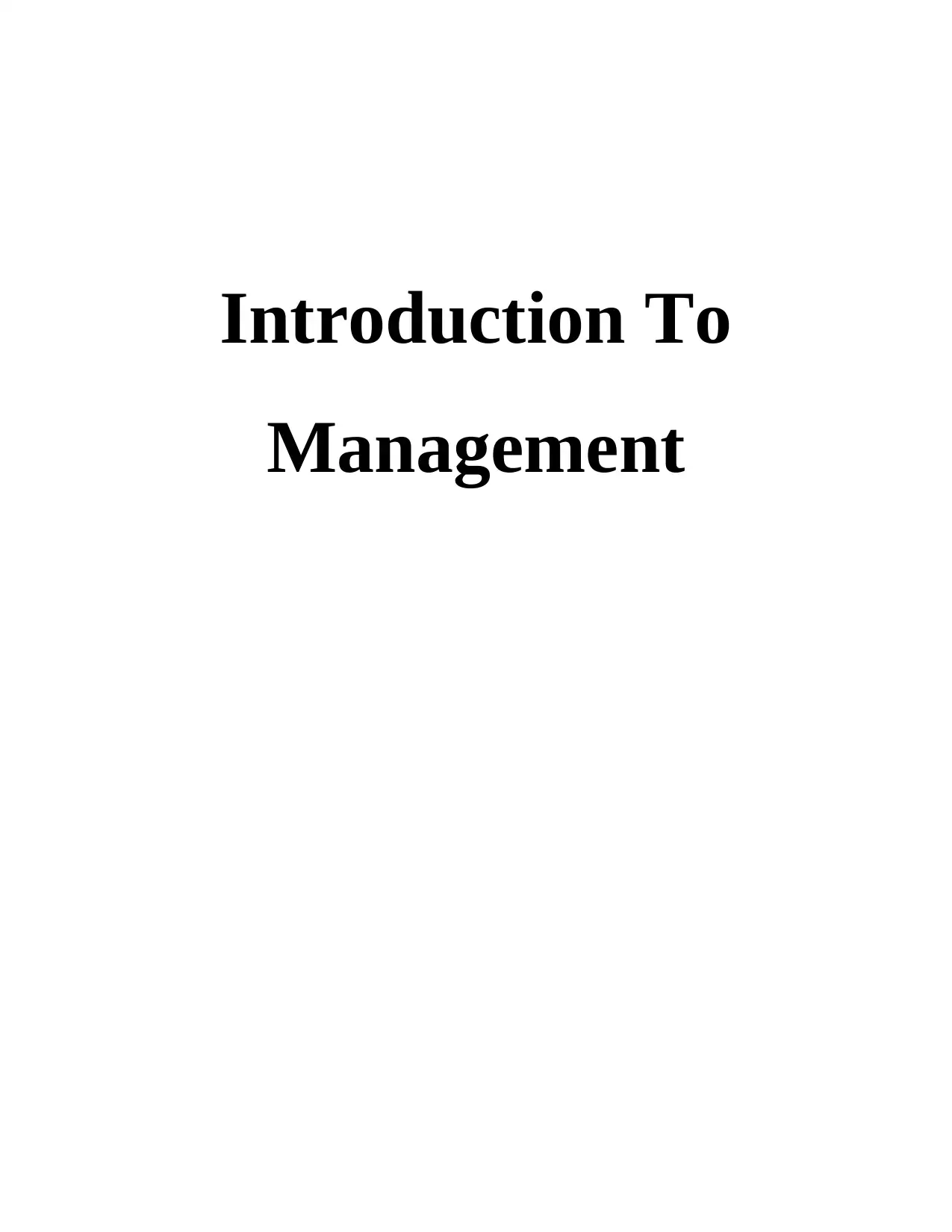
Introduction To
Management
Management
Paraphrase This Document
Need a fresh take? Get an instant paraphrase of this document with our AI Paraphraser
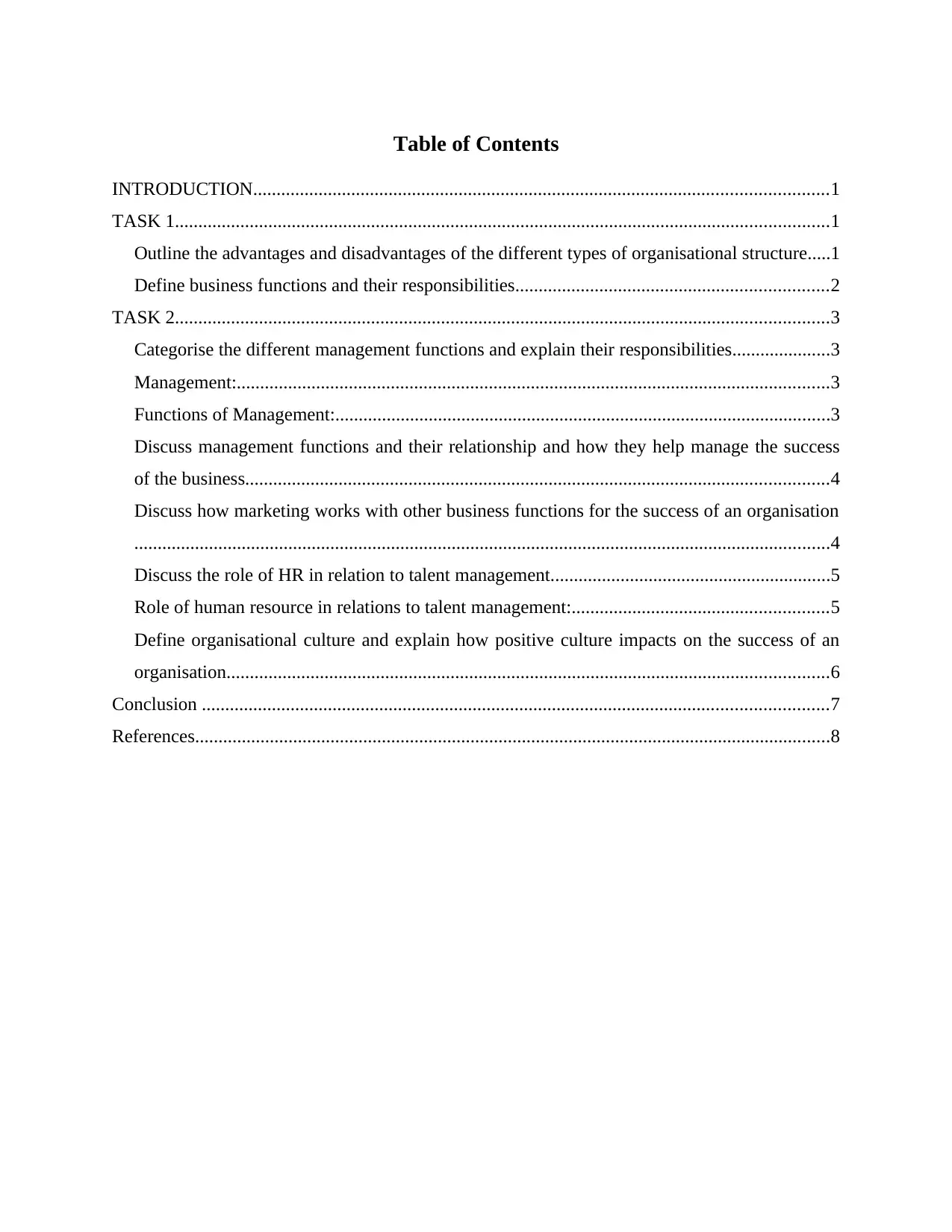
Table of Contents
INTRODUCTION...........................................................................................................................1
TASK 1............................................................................................................................................1
Outline the advantages and disadvantages of the different types of organisational structure.....1
Define business functions and their responsibilities...................................................................2
TASK 2............................................................................................................................................3
Categorise the different management functions and explain their responsibilities.....................3
Management:...............................................................................................................................3
Functions of Management:..........................................................................................................3
Discuss management functions and their relationship and how they help manage the success
of the business.............................................................................................................................4
Discuss how marketing works with other business functions for the success of an organisation
.....................................................................................................................................................4
Discuss the role of HR in relation to talent management............................................................5
Role of human resource in relations to talent management:.......................................................5
Define organisational culture and explain how positive culture impacts on the success of an
organisation.................................................................................................................................6
Conclusion ......................................................................................................................................7
References........................................................................................................................................8
INTRODUCTION...........................................................................................................................1
TASK 1............................................................................................................................................1
Outline the advantages and disadvantages of the different types of organisational structure.....1
Define business functions and their responsibilities...................................................................2
TASK 2............................................................................................................................................3
Categorise the different management functions and explain their responsibilities.....................3
Management:...............................................................................................................................3
Functions of Management:..........................................................................................................3
Discuss management functions and their relationship and how they help manage the success
of the business.............................................................................................................................4
Discuss how marketing works with other business functions for the success of an organisation
.....................................................................................................................................................4
Discuss the role of HR in relation to talent management............................................................5
Role of human resource in relations to talent management:.......................................................5
Define organisational culture and explain how positive culture impacts on the success of an
organisation.................................................................................................................................6
Conclusion ......................................................................................................................................7
References........................................................................................................................................8
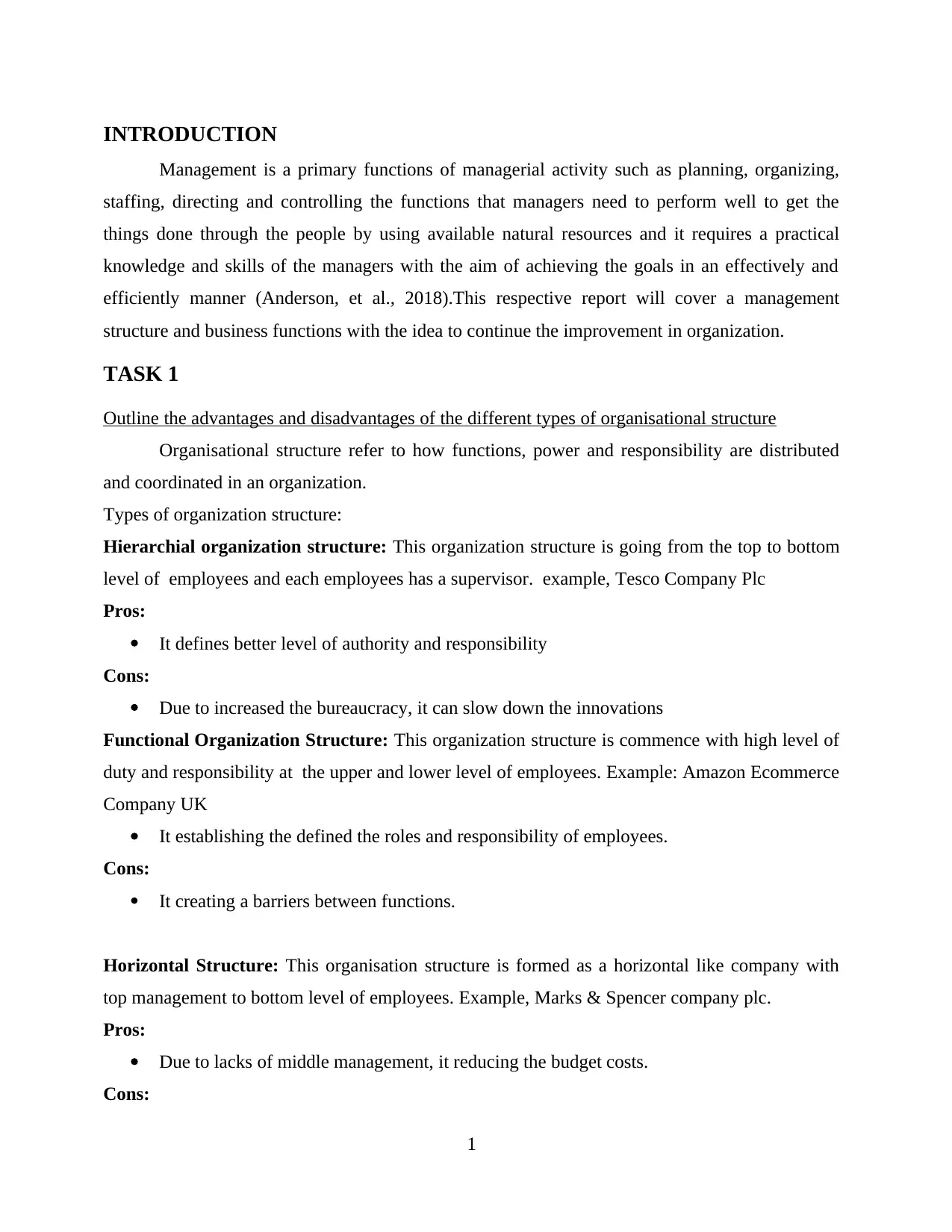
INTRODUCTION
Management is a primary functions of managerial activity such as planning, organizing,
staffing, directing and controlling the functions that managers need to perform well to get the
things done through the people by using available natural resources and it requires a practical
knowledge and skills of the managers with the aim of achieving the goals in an effectively and
efficiently manner (Anderson, et al., 2018).This respective report will cover a management
structure and business functions with the idea to continue the improvement in organization.
TASK 1
Outline the advantages and disadvantages of the different types of organisational structure
Organisational structure refer to how functions, power and responsibility are distributed
and coordinated in an organization.
Types of organization structure:
Hierarchial organization structure: This organization structure is going from the top to bottom
level of employees and each employees has a supervisor. example, Tesco Company Plc
Pros:
It defines better level of authority and responsibility
Cons:
Due to increased the bureaucracy, it can slow down the innovations
Functional Organization Structure: This organization structure is commence with high level of
duty and responsibility at the upper and lower level of employees. Example: Amazon Ecommerce
Company UK
It establishing the defined the roles and responsibility of employees.
Cons:
It creating a barriers between functions.
Horizontal Structure: This organisation structure is formed as a horizontal like company with
top management to bottom level of employees. Example, Marks & Spencer company plc.
Pros:
Due to lacks of middle management, it reducing the budget costs.
Cons:
1
Management is a primary functions of managerial activity such as planning, organizing,
staffing, directing and controlling the functions that managers need to perform well to get the
things done through the people by using available natural resources and it requires a practical
knowledge and skills of the managers with the aim of achieving the goals in an effectively and
efficiently manner (Anderson, et al., 2018).This respective report will cover a management
structure and business functions with the idea to continue the improvement in organization.
TASK 1
Outline the advantages and disadvantages of the different types of organisational structure
Organisational structure refer to how functions, power and responsibility are distributed
and coordinated in an organization.
Types of organization structure:
Hierarchial organization structure: This organization structure is going from the top to bottom
level of employees and each employees has a supervisor. example, Tesco Company Plc
Pros:
It defines better level of authority and responsibility
Cons:
Due to increased the bureaucracy, it can slow down the innovations
Functional Organization Structure: This organization structure is commence with high level of
duty and responsibility at the upper and lower level of employees. Example: Amazon Ecommerce
Company UK
It establishing the defined the roles and responsibility of employees.
Cons:
It creating a barriers between functions.
Horizontal Structure: This organisation structure is formed as a horizontal like company with
top management to bottom level of employees. Example, Marks & Spencer company plc.
Pros:
Due to lacks of middle management, it reducing the budget costs.
Cons:
1
⊘ This is a preview!⊘
Do you want full access?
Subscribe today to unlock all pages.

Trusted by 1+ million students worldwide
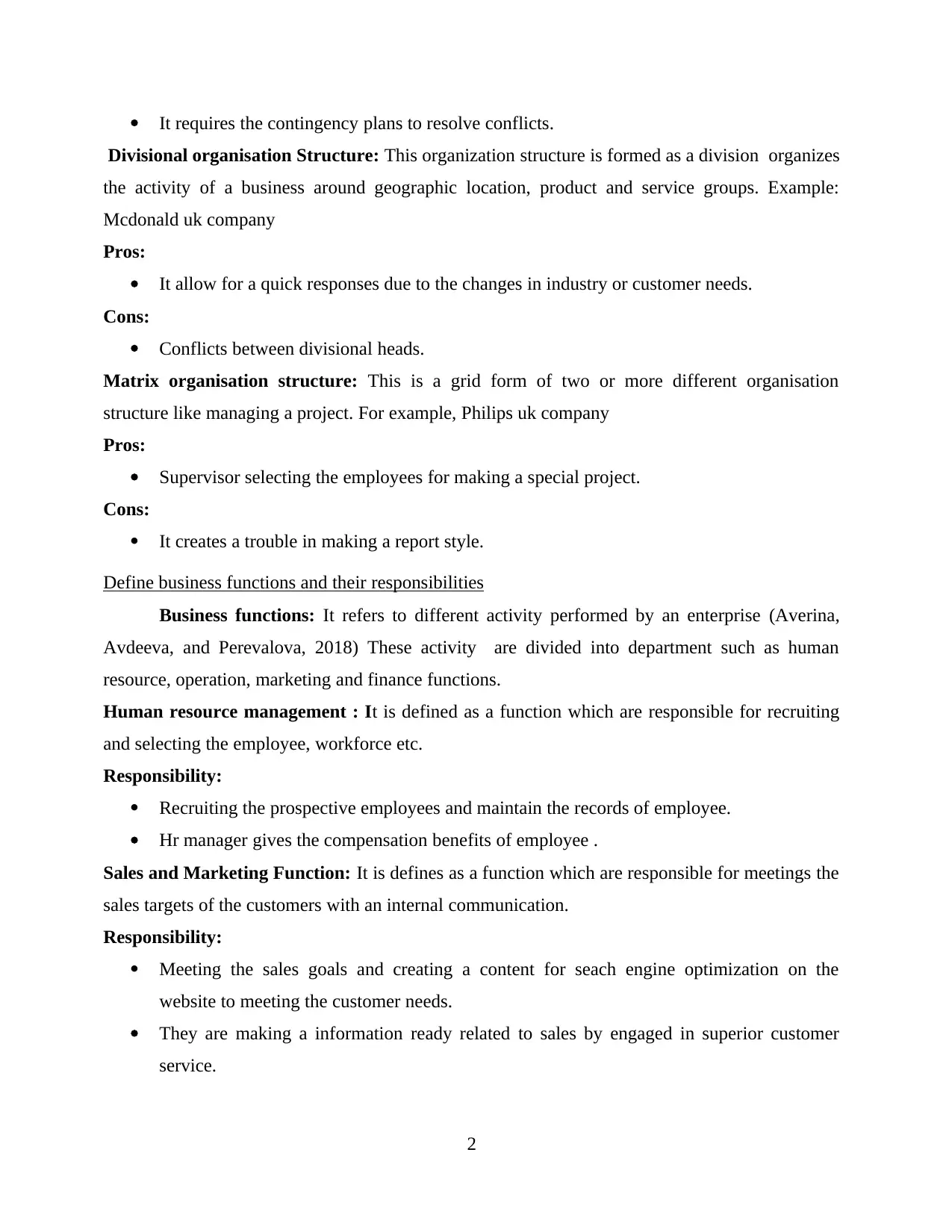
It requires the contingency plans to resolve conflicts.
Divisional organisation Structure: This organization structure is formed as a division organizes
the activity of a business around geographic location, product and service groups. Example:
Mcdonald uk company
Pros:
It allow for a quick responses due to the changes in industry or customer needs.
Cons:
Conflicts between divisional heads.
Matrix organisation structure: This is a grid form of two or more different organisation
structure like managing a project. For example, Philips uk company
Pros:
Supervisor selecting the employees for making a special project.
Cons:
It creates a trouble in making a report style.
Define business functions and their responsibilities
Business functions: It refers to different activity performed by an enterprise (Averina,
Avdeeva, and Perevalova, 2018) These activity are divided into department such as human
resource, operation, marketing and finance functions.
Human resource management : It is defined as a function which are responsible for recruiting
and selecting the employee, workforce etc.
Responsibility:
Recruiting the prospective employees and maintain the records of employee.
Hr manager gives the compensation benefits of employee .
Sales and Marketing Function: It is defines as a function which are responsible for meetings the
sales targets of the customers with an internal communication.
Responsibility:
Meeting the sales goals and creating a content for seach engine optimization on the
website to meeting the customer needs.
They are making a information ready related to sales by engaged in superior customer
service.
2
Divisional organisation Structure: This organization structure is formed as a division organizes
the activity of a business around geographic location, product and service groups. Example:
Mcdonald uk company
Pros:
It allow for a quick responses due to the changes in industry or customer needs.
Cons:
Conflicts between divisional heads.
Matrix organisation structure: This is a grid form of two or more different organisation
structure like managing a project. For example, Philips uk company
Pros:
Supervisor selecting the employees for making a special project.
Cons:
It creates a trouble in making a report style.
Define business functions and their responsibilities
Business functions: It refers to different activity performed by an enterprise (Averina,
Avdeeva, and Perevalova, 2018) These activity are divided into department such as human
resource, operation, marketing and finance functions.
Human resource management : It is defined as a function which are responsible for recruiting
and selecting the employee, workforce etc.
Responsibility:
Recruiting the prospective employees and maintain the records of employee.
Hr manager gives the compensation benefits of employee .
Sales and Marketing Function: It is defines as a function which are responsible for meetings the
sales targets of the customers with an internal communication.
Responsibility:
Meeting the sales goals and creating a content for seach engine optimization on the
website to meeting the customer needs.
They are making a information ready related to sales by engaged in superior customer
service.
2
Paraphrase This Document
Need a fresh take? Get an instant paraphrase of this document with our AI Paraphraser
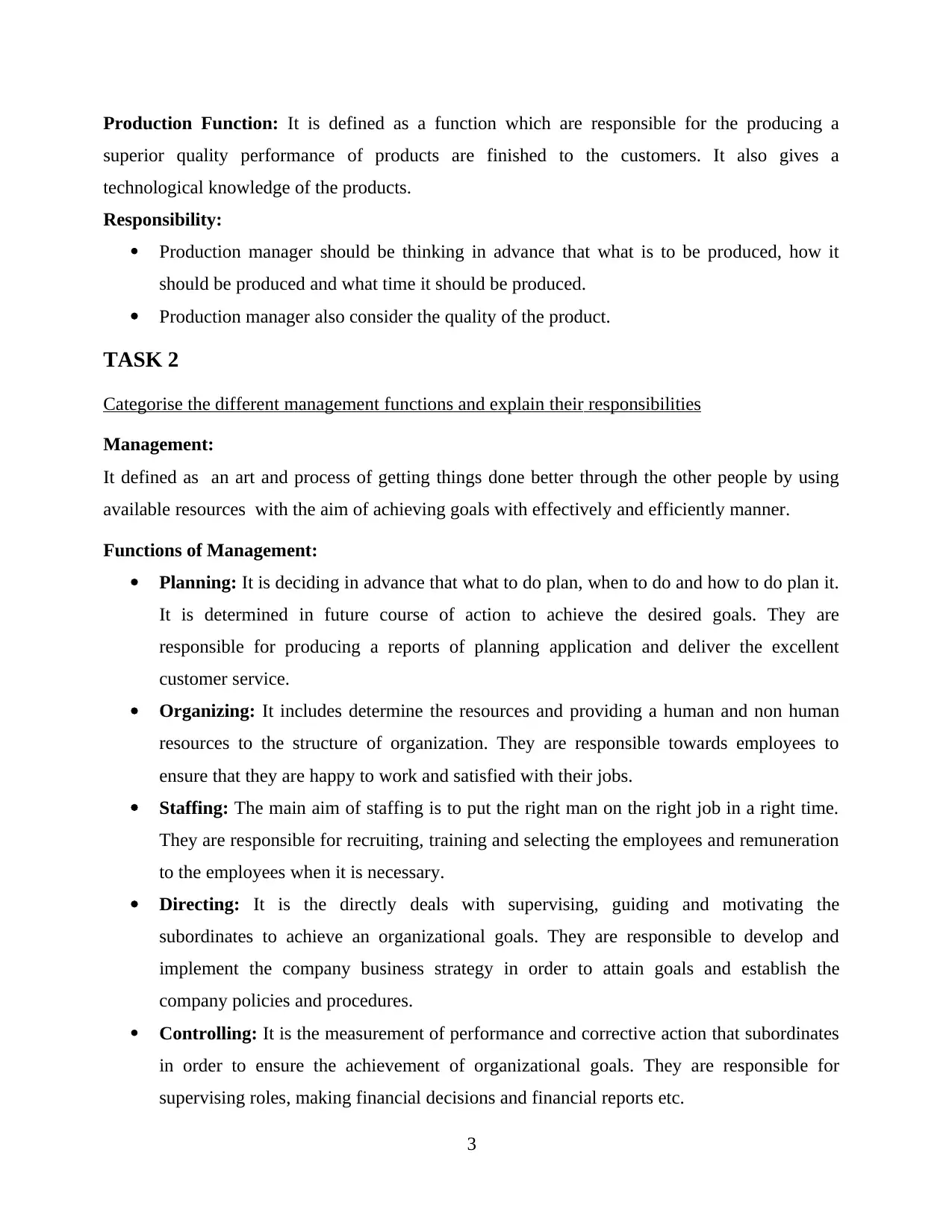
Production Function: It is defined as a function which are responsible for the producing a
superior quality performance of products are finished to the customers. It also gives a
technological knowledge of the products.
Responsibility:
Production manager should be thinking in advance that what is to be produced, how it
should be produced and what time it should be produced.
Production manager also consider the quality of the product.
TASK 2
Categorise the different management functions and explain their responsibilities
Management:
It defined as an art and process of getting things done better through the other people by using
available resources with the aim of achieving goals with effectively and efficiently manner.
Functions of Management:
Planning: It is deciding in advance that what to do plan, when to do and how to do plan it.
It is determined in future course of action to achieve the desired goals. They are
responsible for producing a reports of planning application and deliver the excellent
customer service.
Organizing: It includes determine the resources and providing a human and non human
resources to the structure of organization. They are responsible towards employees to
ensure that they are happy to work and satisfied with their jobs.
Staffing: The main aim of staffing is to put the right man on the right job in a right time.
They are responsible for recruiting, training and selecting the employees and remuneration
to the employees when it is necessary.
Directing: It is the directly deals with supervising, guiding and motivating the
subordinates to achieve an organizational goals. They are responsible to develop and
implement the company business strategy in order to attain goals and establish the
company policies and procedures.
Controlling: It is the measurement of performance and corrective action that subordinates
in order to ensure the achievement of organizational goals. They are responsible for
supervising roles, making financial decisions and financial reports etc.
3
superior quality performance of products are finished to the customers. It also gives a
technological knowledge of the products.
Responsibility:
Production manager should be thinking in advance that what is to be produced, how it
should be produced and what time it should be produced.
Production manager also consider the quality of the product.
TASK 2
Categorise the different management functions and explain their responsibilities
Management:
It defined as an art and process of getting things done better through the other people by using
available resources with the aim of achieving goals with effectively and efficiently manner.
Functions of Management:
Planning: It is deciding in advance that what to do plan, when to do and how to do plan it.
It is determined in future course of action to achieve the desired goals. They are
responsible for producing a reports of planning application and deliver the excellent
customer service.
Organizing: It includes determine the resources and providing a human and non human
resources to the structure of organization. They are responsible towards employees to
ensure that they are happy to work and satisfied with their jobs.
Staffing: The main aim of staffing is to put the right man on the right job in a right time.
They are responsible for recruiting, training and selecting the employees and remuneration
to the employees when it is necessary.
Directing: It is the directly deals with supervising, guiding and motivating the
subordinates to achieve an organizational goals. They are responsible to develop and
implement the company business strategy in order to attain goals and establish the
company policies and procedures.
Controlling: It is the measurement of performance and corrective action that subordinates
in order to ensure the achievement of organizational goals. They are responsible for
supervising roles, making financial decisions and financial reports etc.
3
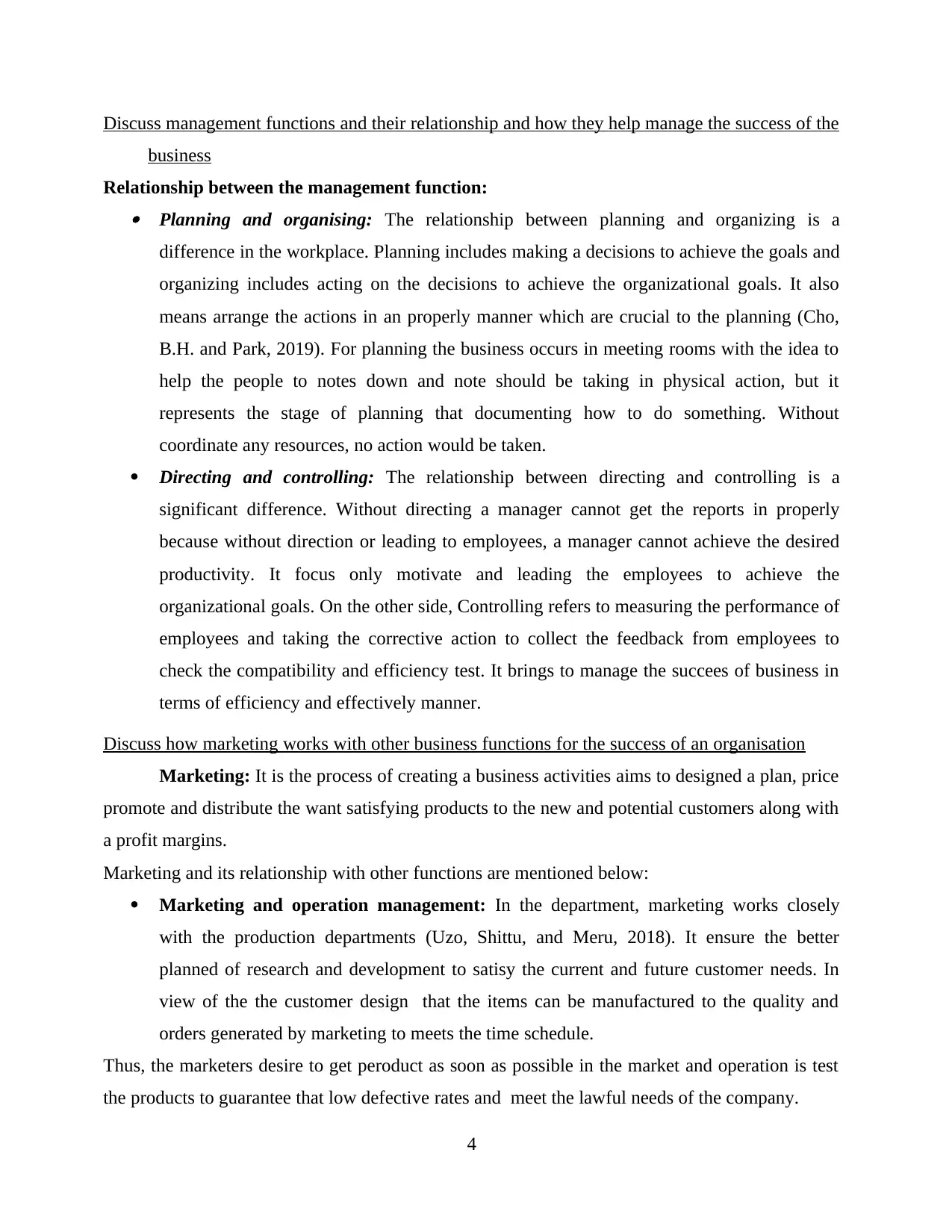
Discuss management functions and their relationship and how they help manage the success of the
business
Relationship between the management function: Planning and organising: The relationship between planning and organizing is a
difference in the workplace. Planning includes making a decisions to achieve the goals and
organizing includes acting on the decisions to achieve the organizational goals. It also
means arrange the actions in an properly manner which are crucial to the planning (Cho,
B.H. and Park, 2019). For planning the business occurs in meeting rooms with the idea to
help the people to notes down and note should be taking in physical action, but it
represents the stage of planning that documenting how to do something. Without
coordinate any resources, no action would be taken.
Directing and controlling: The relationship between directing and controlling is a
significant difference. Without directing a manager cannot get the reports in properly
because without direction or leading to employees, a manager cannot achieve the desired
productivity. It focus only motivate and leading the employees to achieve the
organizational goals. On the other side, Controlling refers to measuring the performance of
employees and taking the corrective action to collect the feedback from employees to
check the compatibility and efficiency test. It brings to manage the succees of business in
terms of efficiency and effectively manner.
Discuss how marketing works with other business functions for the success of an organisation
Marketing: It is the process of creating a business activities aims to designed a plan, price
promote and distribute the want satisfying products to the new and potential customers along with
a profit margins.
Marketing and its relationship with other functions are mentioned below:
Marketing and operation management: In the department, marketing works closely
with the production departments (Uzo, Shittu, and Meru, 2018). It ensure the better
planned of research and development to satisy the current and future customer needs. In
view of the the customer design that the items can be manufactured to the quality and
orders generated by marketing to meets the time schedule.
Thus, the marketers desire to get peroduct as soon as possible in the market and operation is test
the products to guarantee that low defective rates and meet the lawful needs of the company.
4
business
Relationship between the management function: Planning and organising: The relationship between planning and organizing is a
difference in the workplace. Planning includes making a decisions to achieve the goals and
organizing includes acting on the decisions to achieve the organizational goals. It also
means arrange the actions in an properly manner which are crucial to the planning (Cho,
B.H. and Park, 2019). For planning the business occurs in meeting rooms with the idea to
help the people to notes down and note should be taking in physical action, but it
represents the stage of planning that documenting how to do something. Without
coordinate any resources, no action would be taken.
Directing and controlling: The relationship between directing and controlling is a
significant difference. Without directing a manager cannot get the reports in properly
because without direction or leading to employees, a manager cannot achieve the desired
productivity. It focus only motivate and leading the employees to achieve the
organizational goals. On the other side, Controlling refers to measuring the performance of
employees and taking the corrective action to collect the feedback from employees to
check the compatibility and efficiency test. It brings to manage the succees of business in
terms of efficiency and effectively manner.
Discuss how marketing works with other business functions for the success of an organisation
Marketing: It is the process of creating a business activities aims to designed a plan, price
promote and distribute the want satisfying products to the new and potential customers along with
a profit margins.
Marketing and its relationship with other functions are mentioned below:
Marketing and operation management: In the department, marketing works closely
with the production departments (Uzo, Shittu, and Meru, 2018). It ensure the better
planned of research and development to satisy the current and future customer needs. In
view of the the customer design that the items can be manufactured to the quality and
orders generated by marketing to meets the time schedule.
Thus, the marketers desire to get peroduct as soon as possible in the market and operation is test
the products to guarantee that low defective rates and meet the lawful needs of the company.
4
⊘ This is a preview!⊘
Do you want full access?
Subscribe today to unlock all pages.

Trusted by 1+ million students worldwide
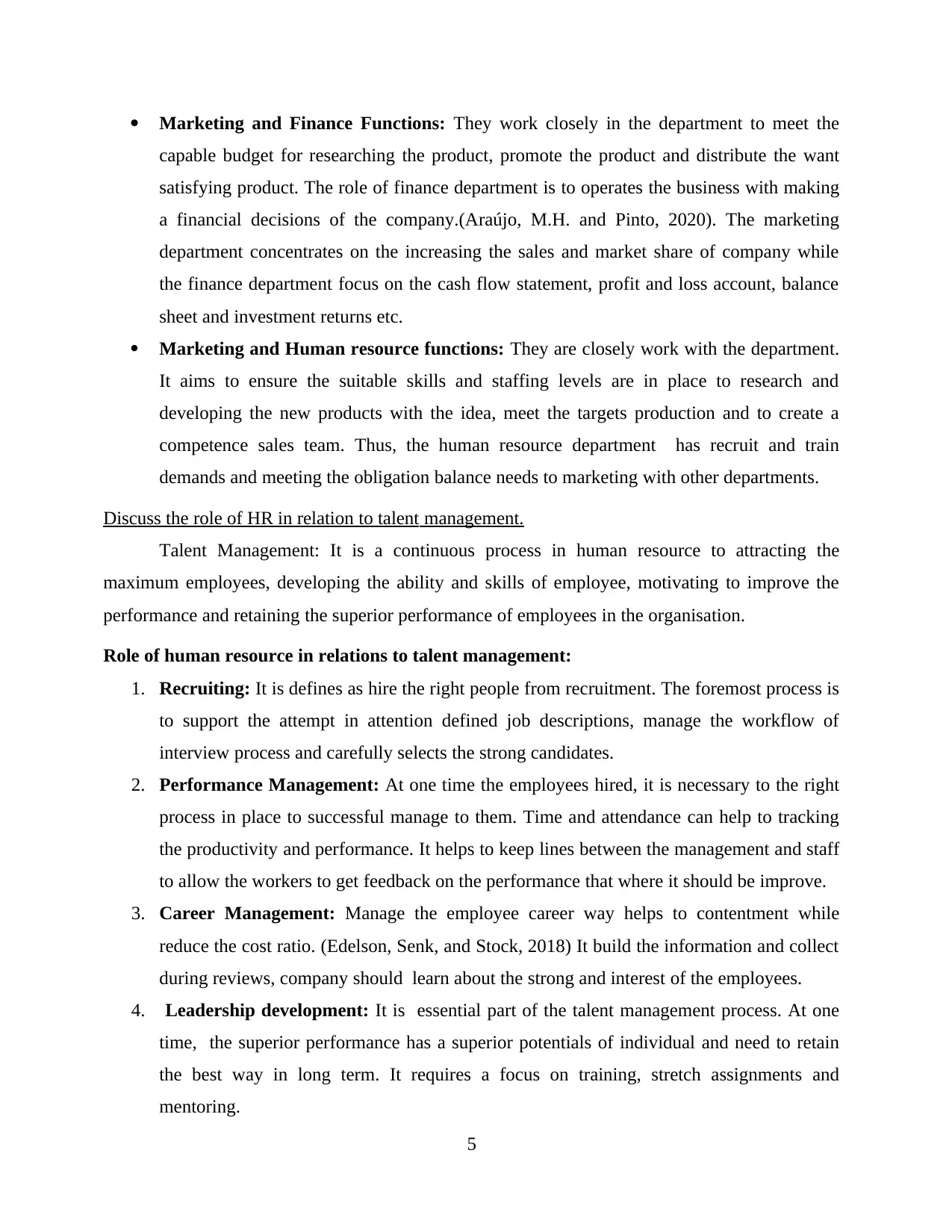
Marketing and Finance Functions: They work closely in the department to meet the
capable budget for researching the product, promote the product and distribute the want
satisfying product. The role of finance department is to operates the business with making
a financial decisions of the company.(Araújo, M.H. and Pinto, 2020). The marketing
department concentrates on the increasing the sales and market share of company while
the finance department focus on the cash flow statement, profit and loss account, balance
sheet and investment returns etc.
Marketing and Human resource functions: They are closely work with the department.
It aims to ensure the suitable skills and staffing levels are in place to research and
developing the new products with the idea, meet the targets production and to create a
competence sales team. Thus, the human resource department has recruit and train
demands and meeting the obligation balance needs to marketing with other departments.
Discuss the role of HR in relation to talent management.
Talent Management: It is a continuous process in human resource to attracting the
maximum employees, developing the ability and skills of employee, motivating to improve the
performance and retaining the superior performance of employees in the organisation.
Role of human resource in relations to talent management:
1. Recruiting: It is defines as hire the right people from recruitment. The foremost process is
to support the attempt in attention defined job descriptions, manage the workflow of
interview process and carefully selects the strong candidates.
2. Performance Management: At one time the employees hired, it is necessary to the right
process in place to successful manage to them. Time and attendance can help to tracking
the productivity and performance. It helps to keep lines between the management and staff
to allow the workers to get feedback on the performance that where it should be improve.
3. Career Management: Manage the employee career way helps to contentment while
reduce the cost ratio. (Edelson, Senk, and Stock, 2018) It build the information and collect
during reviews, company should learn about the strong and interest of the employees.
4. Leadership development: It is essential part of the talent management process. At one
time, the superior performance has a superior potentials of individual and need to retain
the best way in long term. It requires a focus on training, stretch assignments and
mentoring.
5
capable budget for researching the product, promote the product and distribute the want
satisfying product. The role of finance department is to operates the business with making
a financial decisions of the company.(Araújo, M.H. and Pinto, 2020). The marketing
department concentrates on the increasing the sales and market share of company while
the finance department focus on the cash flow statement, profit and loss account, balance
sheet and investment returns etc.
Marketing and Human resource functions: They are closely work with the department.
It aims to ensure the suitable skills and staffing levels are in place to research and
developing the new products with the idea, meet the targets production and to create a
competence sales team. Thus, the human resource department has recruit and train
demands and meeting the obligation balance needs to marketing with other departments.
Discuss the role of HR in relation to talent management.
Talent Management: It is a continuous process in human resource to attracting the
maximum employees, developing the ability and skills of employee, motivating to improve the
performance and retaining the superior performance of employees in the organisation.
Role of human resource in relations to talent management:
1. Recruiting: It is defines as hire the right people from recruitment. The foremost process is
to support the attempt in attention defined job descriptions, manage the workflow of
interview process and carefully selects the strong candidates.
2. Performance Management: At one time the employees hired, it is necessary to the right
process in place to successful manage to them. Time and attendance can help to tracking
the productivity and performance. It helps to keep lines between the management and staff
to allow the workers to get feedback on the performance that where it should be improve.
3. Career Management: Manage the employee career way helps to contentment while
reduce the cost ratio. (Edelson, Senk, and Stock, 2018) It build the information and collect
during reviews, company should learn about the strong and interest of the employees.
4. Leadership development: It is essential part of the talent management process. At one
time, the superior performance has a superior potentials of individual and need to retain
the best way in long term. It requires a focus on training, stretch assignments and
mentoring.
5
Paraphrase This Document
Need a fresh take? Get an instant paraphrase of this document with our AI Paraphraser
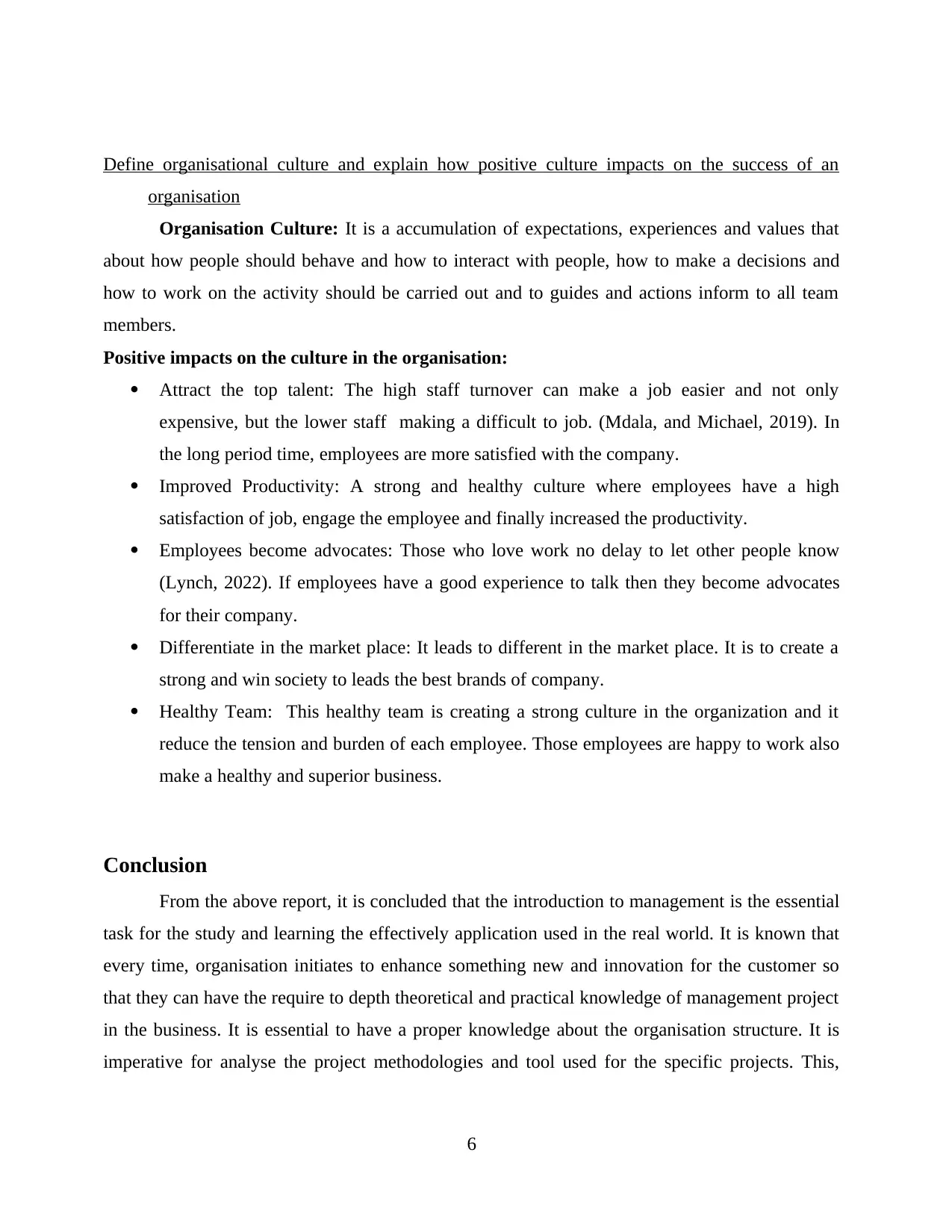
Define organisational culture and explain how positive culture impacts on the success of an
organisation
Organisation Culture: It is a accumulation of expectations, experiences and values that
about how people should behave and how to interact with people, how to make a decisions and
how to work on the activity should be carried out and to guides and actions inform to all team
members.
Positive impacts on the culture in the organisation:
Attract the top talent: The high staff turnover can make a job easier and not only
expensive, but the lower staff making a difficult to job. (Mdala, and Michael, 2019). In
the long period time, employees are more satisfied with the company.
Improved Productivity: A strong and healthy culture where employees have a high
satisfaction of job, engage the employee and finally increased the productivity.
Employees become advocates: Those who love work no delay to let other people know
(Lynch, 2022). If employees have a good experience to talk then they become advocates
for their company.
Differentiate in the market place: It leads to different in the market place. It is to create a
strong and win society to leads the best brands of company.
Healthy Team: This healthy team is creating a strong culture in the organization and it
reduce the tension and burden of each employee. Those employees are happy to work also
make a healthy and superior business.
Conclusion
From the above report, it is concluded that the introduction to management is the essential
task for the study and learning the effectively application used in the real world. It is known that
every time, organisation initiates to enhance something new and innovation for the customer so
that they can have the require to depth theoretical and practical knowledge of management project
in the business. It is essential to have a proper knowledge about the organisation structure. It is
imperative for analyse the project methodologies and tool used for the specific projects. This,
6
organisation
Organisation Culture: It is a accumulation of expectations, experiences and values that
about how people should behave and how to interact with people, how to make a decisions and
how to work on the activity should be carried out and to guides and actions inform to all team
members.
Positive impacts on the culture in the organisation:
Attract the top talent: The high staff turnover can make a job easier and not only
expensive, but the lower staff making a difficult to job. (Mdala, and Michael, 2019). In
the long period time, employees are more satisfied with the company.
Improved Productivity: A strong and healthy culture where employees have a high
satisfaction of job, engage the employee and finally increased the productivity.
Employees become advocates: Those who love work no delay to let other people know
(Lynch, 2022). If employees have a good experience to talk then they become advocates
for their company.
Differentiate in the market place: It leads to different in the market place. It is to create a
strong and win society to leads the best brands of company.
Healthy Team: This healthy team is creating a strong culture in the organization and it
reduce the tension and burden of each employee. Those employees are happy to work also
make a healthy and superior business.
Conclusion
From the above report, it is concluded that the introduction to management is the essential
task for the study and learning the effectively application used in the real world. It is known that
every time, organisation initiates to enhance something new and innovation for the customer so
that they can have the require to depth theoretical and practical knowledge of management project
in the business. It is essential to have a proper knowledge about the organisation structure. It is
imperative for analyse the project methodologies and tool used for the specific projects. This,
6
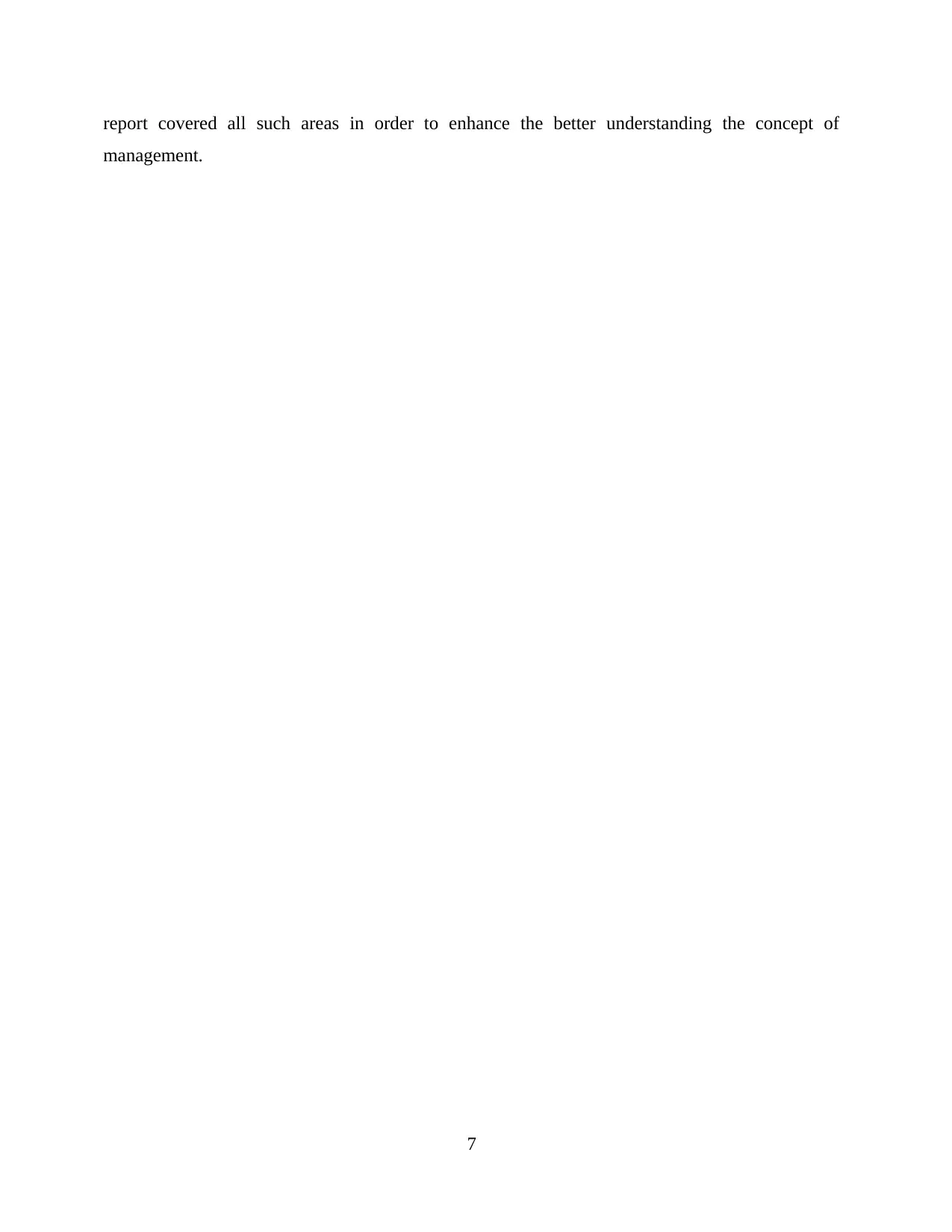
report covered all such areas in order to enhance the better understanding the concept of
management.
7
management.
7
⊘ This is a preview!⊘
Do you want full access?
Subscribe today to unlock all pages.

Trusted by 1+ million students worldwide
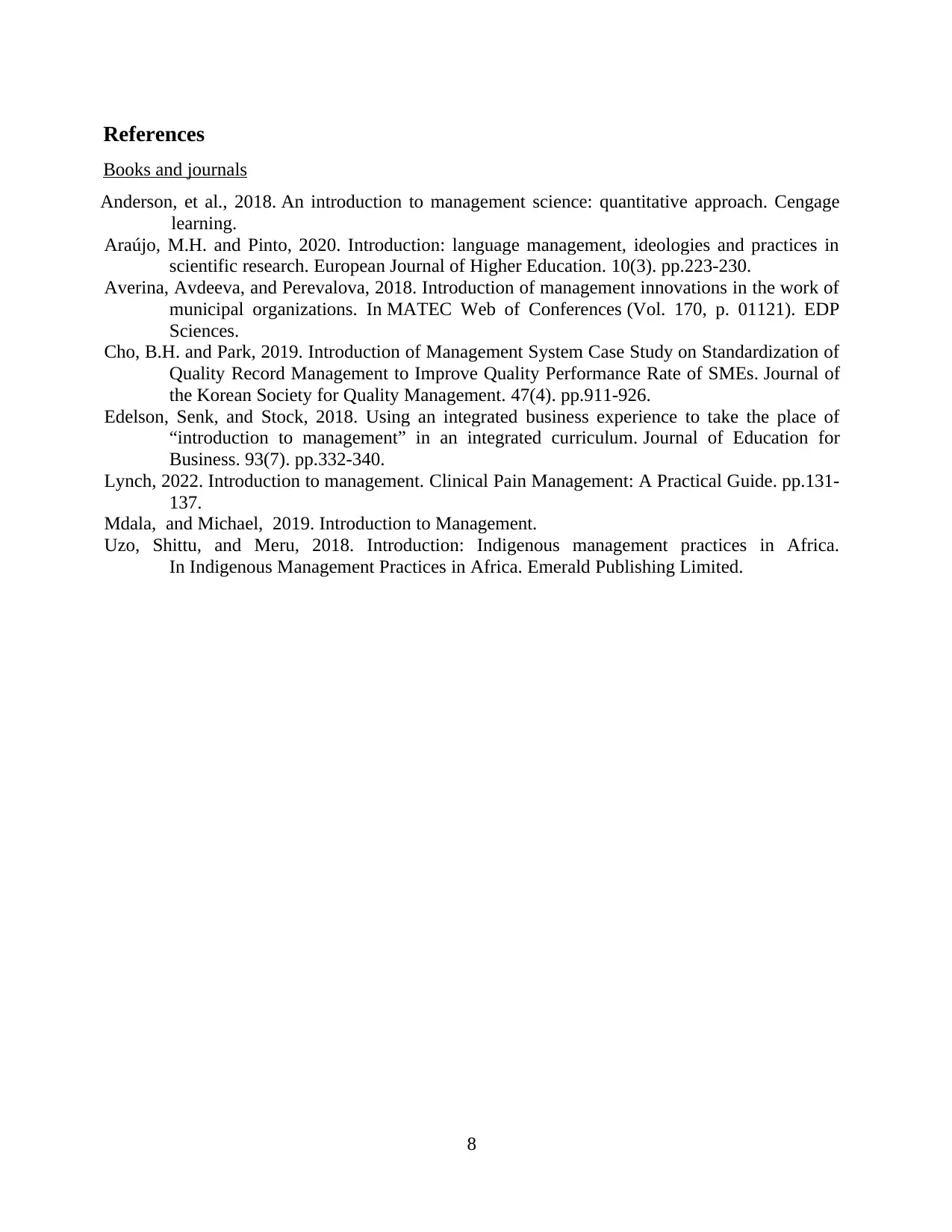
References
Books and journals
Anderson, et al., 2018. An introduction to management science: quantitative approach. Cengage
learning.
Araújo, M.H. and Pinto, 2020. Introduction: language management, ideologies and practices in
scientific research. European Journal of Higher Education. 10(3). pp.223-230.
Averina, Avdeeva, and Perevalova, 2018. Introduction of management innovations in the work of
municipal organizations. In MATEC Web of Conferences (Vol. 170, p. 01121). EDP
Sciences.
Cho, B.H. and Park, 2019. Introduction of Management System Case Study on Standardization of
Quality Record Management to Improve Quality Performance Rate of SMEs. Journal of
the Korean Society for Quality Management. 47(4). pp.911-926.
Edelson, Senk, and Stock, 2018. Using an integrated business experience to take the place of
“introduction to management” in an integrated curriculum. Journal of Education for
Business. 93(7). pp.332-340.
Lynch, 2022. Introduction to management. Clinical Pain Management: A Practical Guide. pp.131-
137.
Mdala, and Michael, 2019. Introduction to Management.
Uzo, Shittu, and Meru, 2018. Introduction: Indigenous management practices in Africa.
In Indigenous Management Practices in Africa. Emerald Publishing Limited.
8
Books and journals
Anderson, et al., 2018. An introduction to management science: quantitative approach. Cengage
learning.
Araújo, M.H. and Pinto, 2020. Introduction: language management, ideologies and practices in
scientific research. European Journal of Higher Education. 10(3). pp.223-230.
Averina, Avdeeva, and Perevalova, 2018. Introduction of management innovations in the work of
municipal organizations. In MATEC Web of Conferences (Vol. 170, p. 01121). EDP
Sciences.
Cho, B.H. and Park, 2019. Introduction of Management System Case Study on Standardization of
Quality Record Management to Improve Quality Performance Rate of SMEs. Journal of
the Korean Society for Quality Management. 47(4). pp.911-926.
Edelson, Senk, and Stock, 2018. Using an integrated business experience to take the place of
“introduction to management” in an integrated curriculum. Journal of Education for
Business. 93(7). pp.332-340.
Lynch, 2022. Introduction to management. Clinical Pain Management: A Practical Guide. pp.131-
137.
Mdala, and Michael, 2019. Introduction to Management.
Uzo, Shittu, and Meru, 2018. Introduction: Indigenous management practices in Africa.
In Indigenous Management Practices in Africa. Emerald Publishing Limited.
8
1 out of 10
Related Documents
Your All-in-One AI-Powered Toolkit for Academic Success.
+13062052269
info@desklib.com
Available 24*7 on WhatsApp / Email
![[object Object]](/_next/static/media/star-bottom.7253800d.svg)
Unlock your academic potential
Copyright © 2020–2025 A2Z Services. All Rights Reserved. Developed and managed by ZUCOL.

